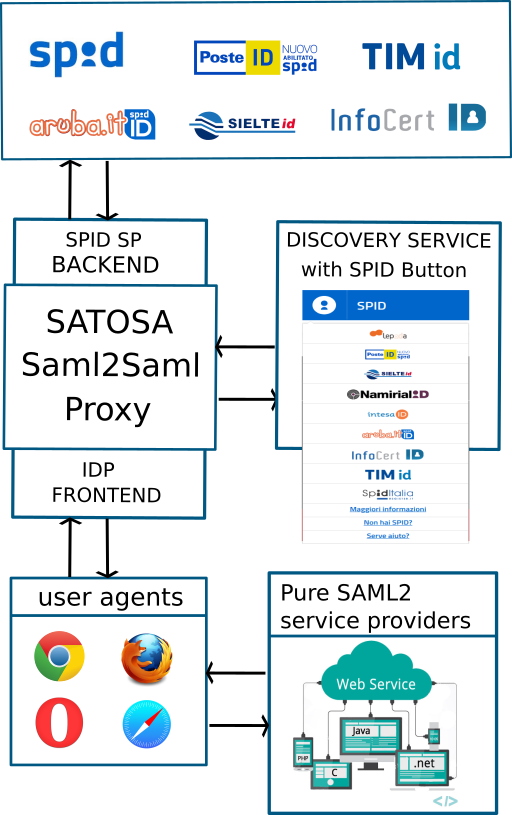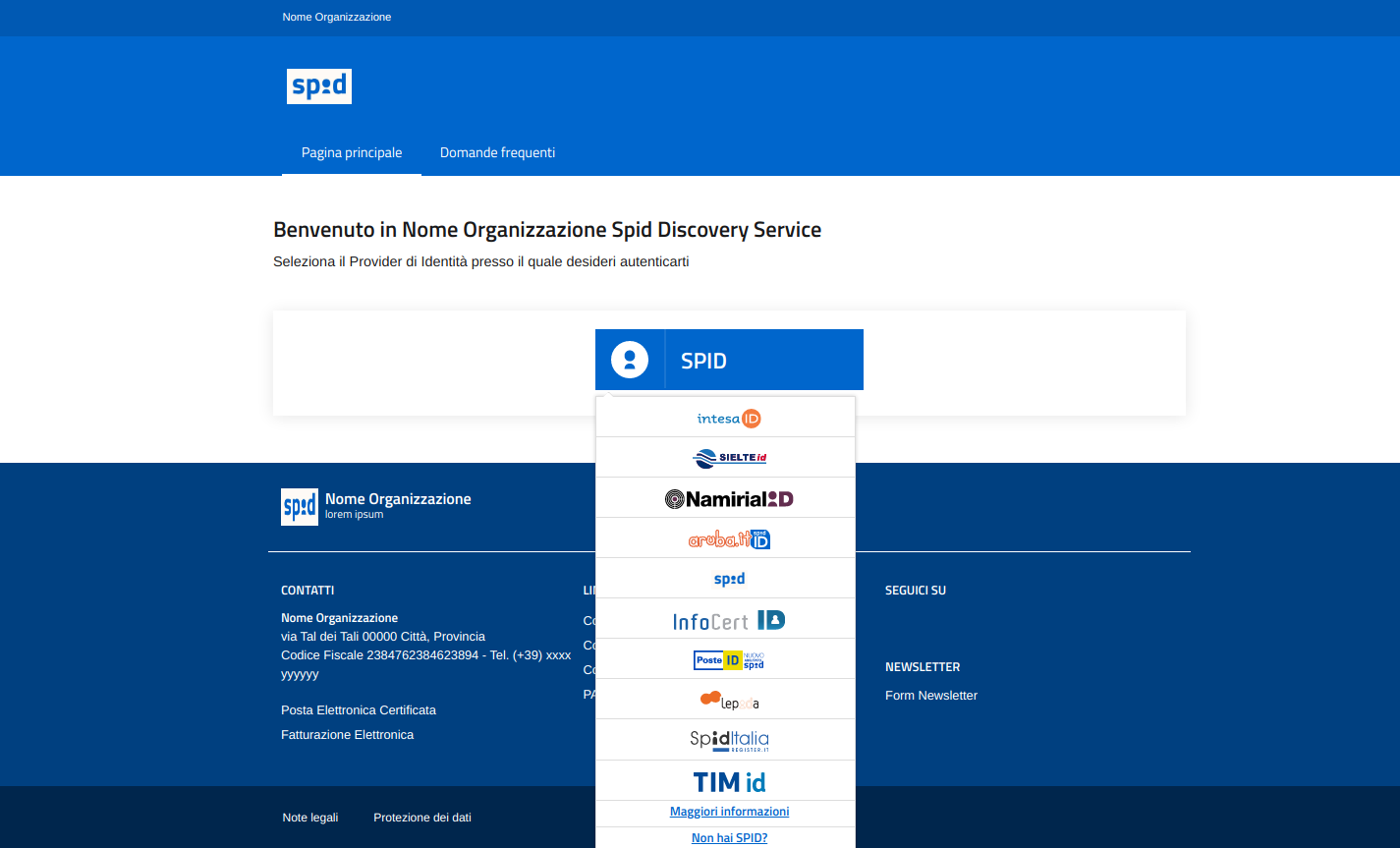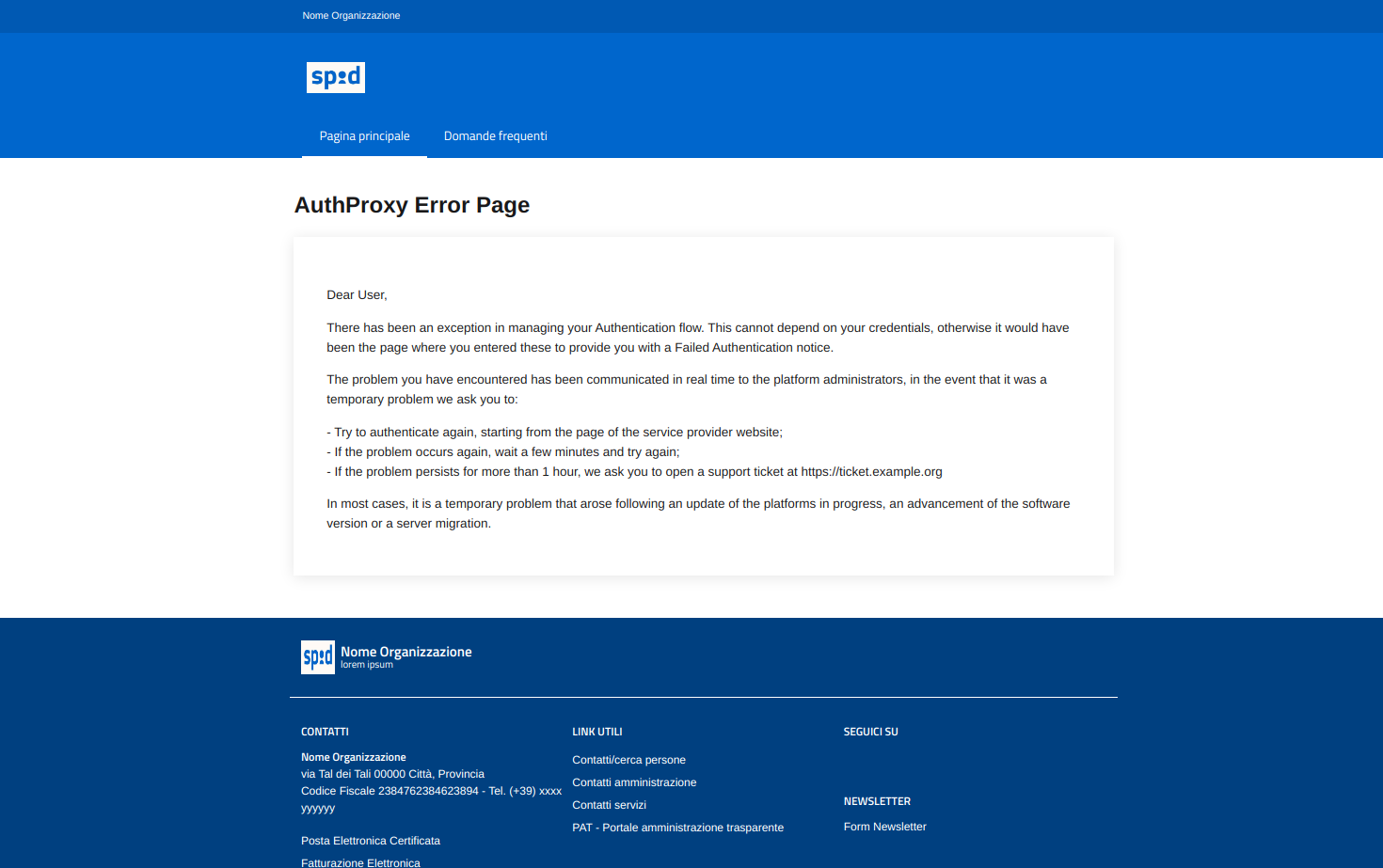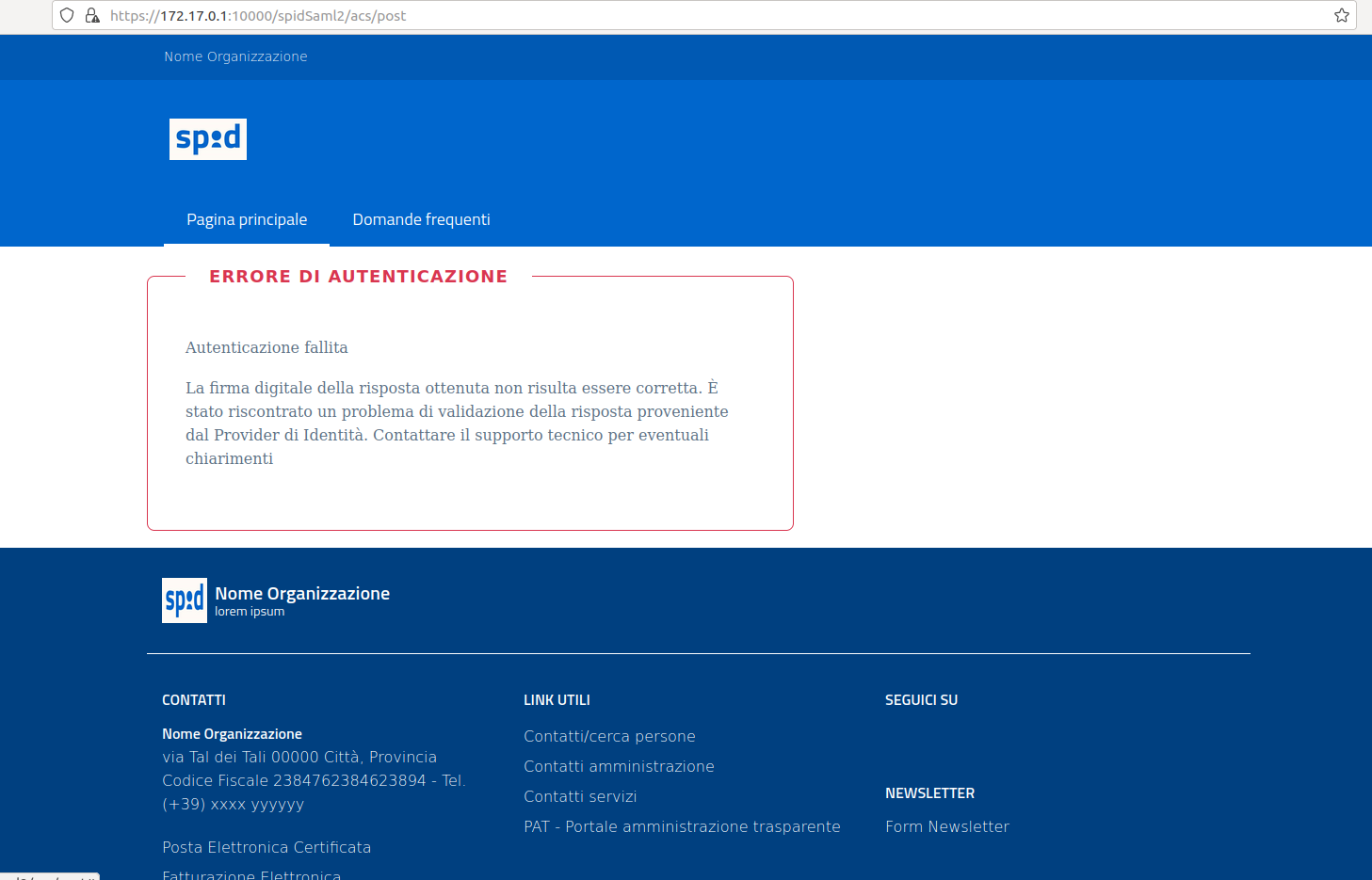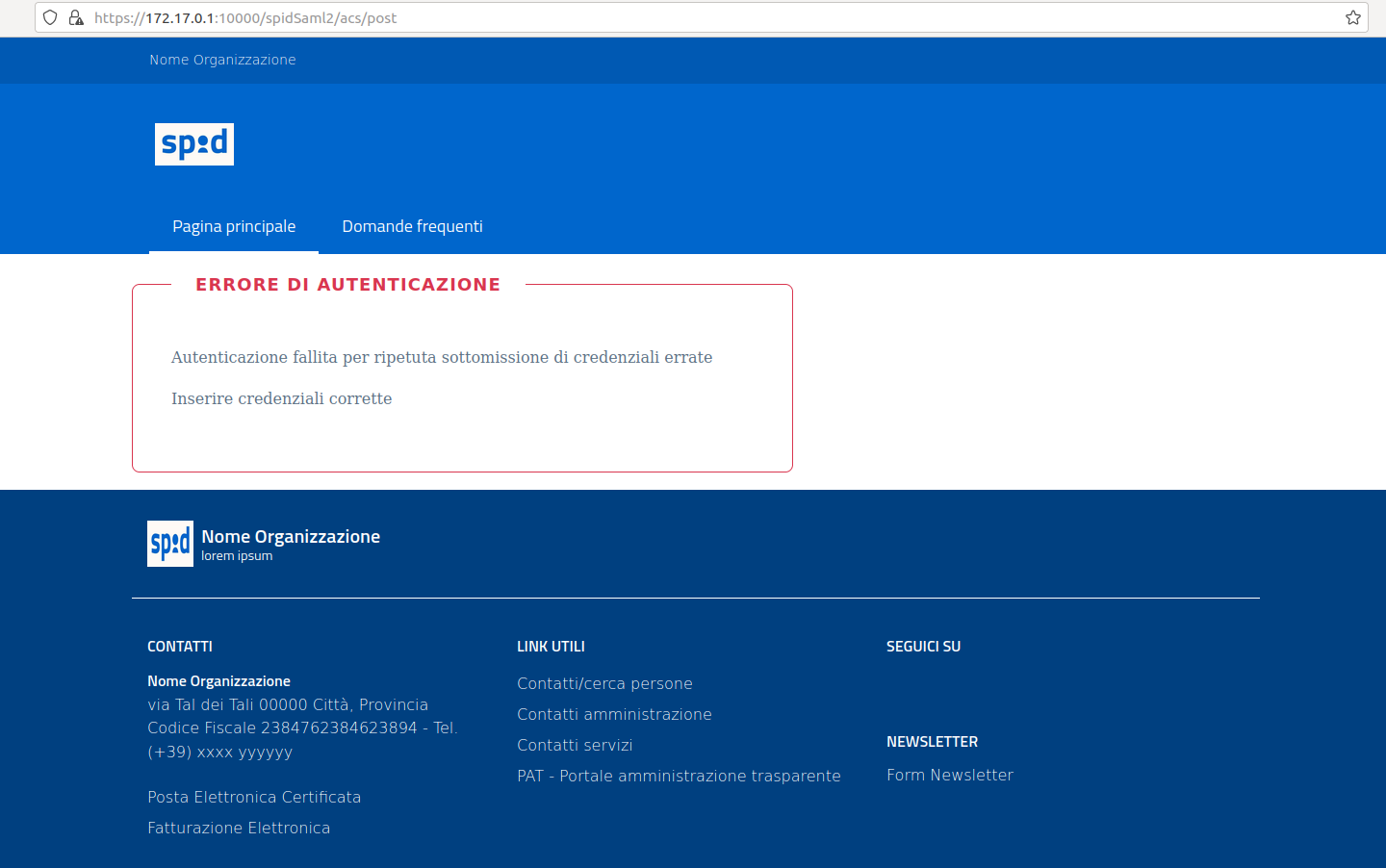This is a SAML2/OIDC configuration for SATOSA that aims to setup a SAML-to-SAML Proxy and OIDC-to-SAML compatible with the SPID - the Italian Digital Identity System.
- Goal
- Demo components
- Docker stack
- Setup
- Start the Proxy
- Additional technical informations
- Author
- Credits
- SPID SP
- eIDAS FICEP SP (see ficep support PR here)
- SAML2 IDP
- OIDC OP (see satosa-oidcop)
Satosa-Saml2 Spid is an intermediary between many SAML2/OIDC Service Providers (RP) and many SAML2 Identity Providers. Specifically it allows traditional Saml2 Service Providers to communicate with Spid Identity Providers adapting Metadata and AuthnRequest operations to the Spid technical requirements.
Figure1 : Common scenario, a traditional SAML2 Service Provider (SP) that's proxied through the SATOSA SPID Backend gets compliances on AuthnRequest and Metadata operations.
More generally this solution allows us to adopt multiple proxy frontends and backends to adapt and allows to communicate systems that, due to protocol or specific limitations, traditionally could not interact each other.
Short glossary
- Frontend, interface of the proxy that is configured as a SAML2 Identity Provider
- Backend, interface of the proxy that is configured as a SAML2 Service Provider
- TargetRouting, a SATOSA microservice for selecting the output backend to reach the endpoint (IdP) selected by the user
- Discovery Service, interface that allows users to select the authentication endpoint
The example project comes with the following demo pages, served with the help of an additional webserver dedicated for static contents:
You can find these demo pages in example/static and edit at your taste.
To get redirection to these pages, or redirection to third-party services, consider the following configuration files:
example/proxy_conf.yml, example:UNKNOW_ERROR_REDIRECT_PAGE: "https://localhost:9999/error_page.html"example/plugins/{backends,frontends}/$filename, example:disco_srv: "https://localhost:9999/static/disco.html"
Remember to edit and customize all the values like "CHANGE_ME!" in the configuration files, in proxy_conf.yaml and in plugins configurations.
apt install jq
pip install docker-compose
Create your project folder, starting from our example project
cp -R example project
# do your customizations in project/
Create volumes
docker volume create --name=satosa-saml2saml_certs
docker volume create --name=satosa-saml2saml_conf
docker volume create --name=satosa-saml2saml_statics
docker volume create --name=satosa-saml2saml_logs
Where the data are
docker volume ls
Copy files in destination volumes
cp project/pki/*pem `docker volume inspect satosa-saml2saml_certs | jq .[0].Mountpoint | sed 's/"//g'`
cp -R project/* `docker volume inspect satosa-saml2saml_conf | jq .[0].Mountpoint | sed 's/"//g'`
cp -R project/static/* `docker volume inspect satosa-saml2saml_statics | jq .[0].Mountpoint | sed 's/"//g'`
Run the stack
docker-compose up
See mongo readme to have some example of demo data.
this project uses SATOSA_oidcop as OAuth2/OIDC frontend module. Comment/uncomment the following statement in the proxy_configuration to enable it.
https://github.com/italia/Satosa-Saml2Spid/blob/oidcop/example/proxy_conf.yaml#L32
mkdir satosa_proxy && cd satosa_proxy
virtualenv -ppython3 satosa.env
source satosa.env/bin/activate
sudo apt install -y libffi-dev libssl-dev python3-pip xmlsec1 procps libpcre3 libpcre3-dev
git clone https://github.com/italia/Satosa-Saml2Spid.git repository
pip install -r repository/requirements.txt
sudo yum install -y libffi-devel openssl-devel python3-pip xmlsec1 procps pcre pcre-devel
pip install --upgrade pip
sudo yum groupinstall "Development Tools"
sudo yum install -y python3-wheel python3-devel
git clone https://github.com/italia/Satosa-Saml2Spid.git repository
pip install -r repository/requirements.txt
- Create certificates for SPID see psmiraglia.
- Copy
repository/example/*contents (cp -R repository/example/* .) and edit the following files with your preferred configuration.
These are the configuration files:
proxy_conf.yamlplugins/backends/spidsaml2_backend.yamlplugins/backends/saml2_backend.yamlplugins/frontend/saml2_frontend.yamlplugins/frontend/oidc_op_frontend.yaml(optional to enable OIDC Provider)
If you want to handle metadata file manually, as this example purpose as demostration,
create metadata/idp and metadata/sp folders, then copy metadata:
mkdir -p metadata/idp metadata/sp
wget https://localhost:8080/metadata.xml -O metadata/idp/spid-saml-check.xml
wget https://registry.spid.gov.it/metadata/idp/spid-entities-idps.xml -O metadata/idp/spid-entities-idps.xml
Copy your SP metadata to your Proxy
wget https://sp.fqdn.org/saml2/metadata -O metadata/sp/my-sp.xml
Otherwise the best method would be enabling a MDQ server in each frontend and backend configuration file.
See example/plugins/{backends,frontends}/$filename as example.
Warning: these examples must be intended only for test purpose, for a demo run. Please remember that the following examples wouldn't be intended for a real production environment! If you need some example for a production environment please take a look at example/uwsgi_setup/ folder.
export SATOSA_APP=$VIRTUAL_ENV/lib/$(python -c 'import sys; print(f"python{sys.version_info.major}.{sys.version_info.minor}")')/site-packages/satosa
# only https with satosa, because its Cookie only if "secure" would be sent
uwsgi --wsgi-file $SATOSA_APP/wsgi.py --https 0.0.0.0:10000,./pki/cert.pem,./pki/privkey.pem --callable app -b 32768
# additional static serve for the demo Discovery Service with Spid button
uwsgi --https 0.0.0.0:9999,./pki/cert.pem,./pki/privkey.pem --check-static-docroot --check-static ./static/ --static-index disco.html
The proxy backend exposes its SPID metadata at the following url (customizable):
https://localhost:10000/spidSaml2/metadata
The Proxy metadata must be configured in your SP. Your SP is an entity that's external from this Proxy, eg: shibboleth sp, djangosaml2, another ...
wget https://localhost:10000/Saml2IDP/metadata -O path/to/your/sp/metadata/satosa-spid.xml --no-check-certificate
Then start an authentication from your SP.
 Figure 2: The result using spid-saml-check.
Figure 2: The result using spid-saml-check.
If you're doing tests and you don't want to pass by Discovery page each time you can use idphinting but only if your SP support it! Here an example using djangosaml2 as SP:
http://localhost:8000/saml2/login/?idp=https://localhost:10000/Saml2IDP/metadata&next=/saml2/echo_attributes&idphint=https%253A%252F%252Flocalhost%253A8080
IF you're going to test Satosa-Saml2Spid with spid-sp-test, take a look to its CI, here,
That's the stdout log of a working instance of SATOSA in uwsgi
*** Starting uWSGI 2.0.19.1 (64bit) on [Tue Mar 30 17:08:49 2021] ***
compiled with version: 9.3.0 on 11 September 2020 23:11:42
os: Linux-5.4.0-70-generic #78-Ubuntu SMP Fri Mar 19 13:29:52 UTC 2021
nodename: wert-desktop
machine: x86_64
clock source: unix
pcre jit disabled
detected number of CPU cores: 8
current working directory: /path/to/IdentityPython/satosa_proxy
detected binary path: /path/to/IdentityPython/satosa_proxy/satosa.env/bin/uwsgi
your processes number limit is 62315
your memory page size is 4096 bytes
detected max file descriptor number: 1024
lock engine: pthread robust mutexes
uWSGI http bound on 0.0.0.0:10000 fd 4
spawned uWSGI http 1 (pid: 28676)
uwsgi socket 0 bound to TCP address 127.0.0.1:39553 (port auto-assigned) fd 3
Python version: 3.8.5 (default, Jan 27 2021, 15:41:15) [GCC 9.3.0]
Python main interpreter initialized at 0x55f744576790
your server socket listen backlog is limited to 100 connections
your mercy for graceful operations on workers is 60 seconds
mapped 72920 bytes (71 KB) for 1 cores
*** Operational MODE: single process ***
[2021-03-30 17:08:50] [INFO ]: Running SATOSA version 7.0.1 [satosa.proxy_server.make_app:165]
[2021-03-30 17:08:50] [INFO ]: Loading backend modules... [satosa.base.__init__:42]
[2021-03-30 17:08:51] [INFO ]: Setup backends: ['Saml2', 'spidSaml2'] [satosa.plugin_loader.load_backends:49]
[2021-03-30 17:08:51] [INFO ]: Loading frontend modules... [satosa.base.__init__:45]
[2021-03-30 17:08:51] [INFO ]: Setup frontends: ['Saml2IDP'] [satosa.plugin_loader.load_frontends:70]
[2021-03-30 17:08:51] [INFO ]: Loading micro services... [satosa.base.__init__:51]
[2021-03-30 17:08:51] [INFO ]: Loaded request micro services: ['DecideBackendByTarget'] [satosa.plugin_loader.load_request_microservices:260]
[2021-03-30 17:08:51] [INFO ]: Loaded response micro services:[] [satosa.plugin_loader.load_response_microservices:281]
WSGI app 0 (mountpoint='') ready in 2 seconds on interpreter 0x55f744576790 pid: 28675 (default app)
*** uWSGI is running in multiple interpreter mode ***
spawned uWSGI worker 1 (and the only) (pid: 28675, cores: 8)
The SaToSa SPID backend contained in this project adopt specialized forks of pySAML2 and SATOSA, that implements the following patches, read this for any further explaination about how to patch by hands.
All the patches and features are currently merged and available with the following releases:
These are mandatory only for getting Spid SAML2 working, these are not needed for any other traditional SAML2 deployment:
- date_xsd_type
- disabled_weak_algs
- ns_prefixes
- SATOSA unknow error handling
- SATOSA redirect page on error
Here something that you should know before start.
- You must enable more than a single IdP (multiple metadata or single metadata with multiple entities) to get Discovery Service working.
- Proxy doesn't handle SAML2 SLO, so the spidSaml2 backend is configured with Authnforce -> True. For any further information see Single Logout in Satosa.
- SATOSA Saml2 backend configuration have a policy section that will let us to define specialized behaviours
and configuration for each SP (each by entityid). In this example I defined a single "default" behaviour with attributes name_format
to urn:oasis:names:tc:SAML:2.0:attrname-format:uri, due to my needs to handle many service providers for which it could be painfull do a static definition each time.
An additional "hack" have been made in
example/attributes-maps/satosa_spid_uri_hybrid.py, where I adopted a hybrid mapping that works for both URI and BASIC formats. Feel free to customized or decouple these format in different files and per SP.
SATOSA Official Documentation is available at the following links, make sure you've taken a look to these to understand the potential of this platform:
Account Linking
- pyMultiLDAP SaToSa MS
- Attributes Processing with SATOSA-uniext
Additional resources:
- satosa-eidas-ansible
- aws-saml-proxy
- satosa-oidc-to-sam
- SaToSa training aarc project
- IDP/SP Discovery service
- https://github.com/IdentityPython/SATOSA/blob/master/doc/README.md#frontend
- saml2.0 IdP and SP for tests
- https://www.spid.gov.it/assets/download/SPID_QAD.pdf
Giuseppe De Marco
- Andrea Ranaldi and his Team in ISPRA Ambiente
- Fulvio Scorza and his Team in Università del Piemonte Orientale
- Paolo Smiraglia (SPID certs)
- idpy Community (pySAML2 and SATOSA)
